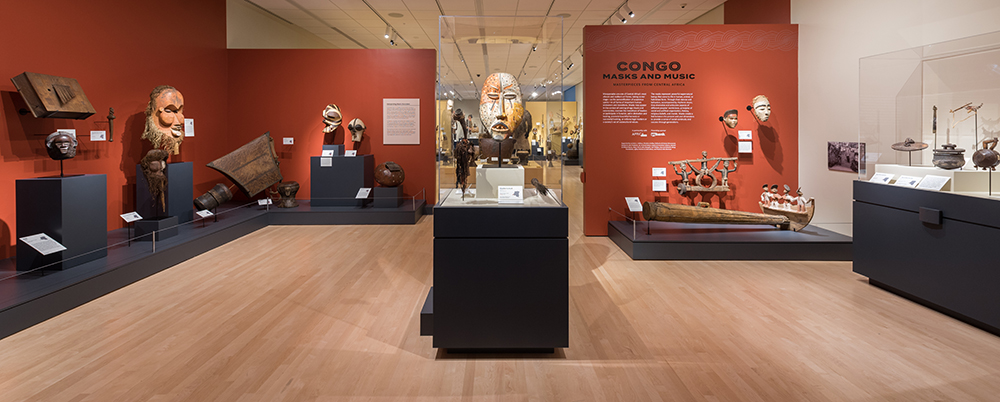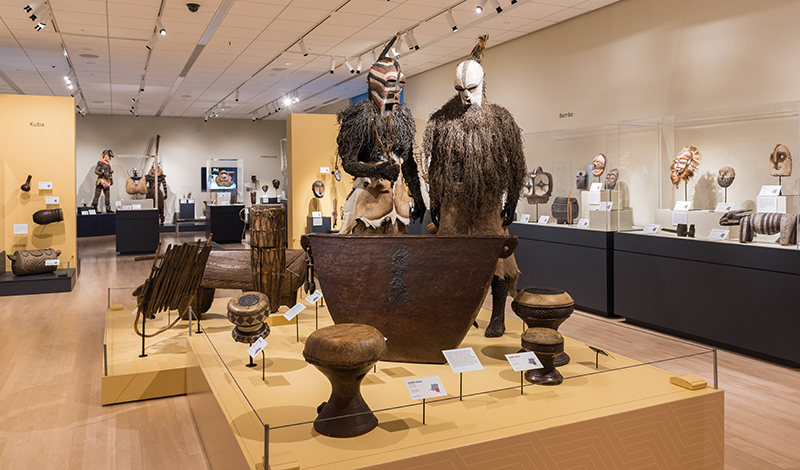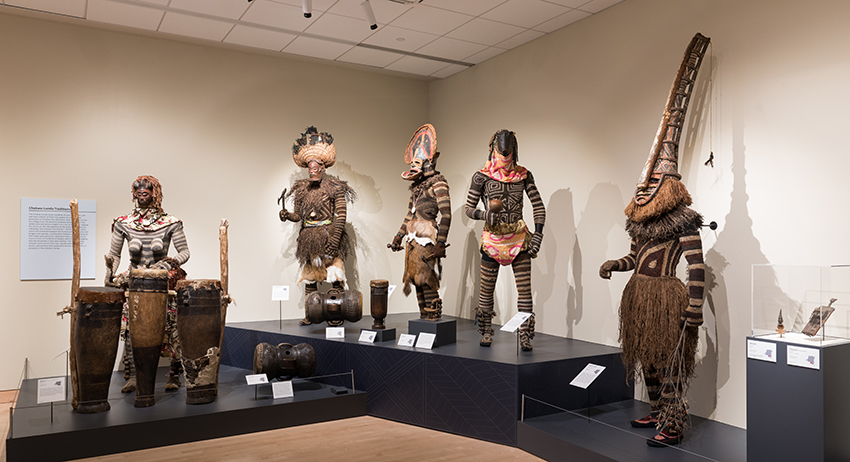A Cultural Masquerade

Writer Joseph J. Airdo
Photography Courtesy of the Musical Instrument Museum
[dropcap]Y[/dropcap]ou may at first feel a little uneasy upon walking into the Musical Instrument Museum’s new special exhibition Congo Masks and Music: Masterpieces from Central Africa. But do not worry—that feeling is normal.
“Masks have a threatening character,” says Marc Felix, one of the museum’s board members. “Their job is to frighten you. But I hope that when people look closer at them, they will understand their humanity and their intricacy.”
Running through Sept. 13, the special exhibition—the first of its kind to fully contextualize masks alongside musical instruments in their authentic performance settings—offers a glimpse into the dramatic and lively masquerade traditions of Central Africa.
“We included masks in the exhibit because the majority of musical instruments in Congo are used in a masking context,” Felix explains.
Congo Masks and Music: Masterpieces of Central Africa features an exclusive collection of more than 150 stunning and rare masks, instruments and costumes from the late 1800s to the early 1900s. Archival photography and video footage featuring masks and traditional music performed in ceremonies accentuate the experience.
A Big Mission
Felix has been collecting Central African masks in the field since 1959 and, to this day, continues to search for missing examples. He believes that Congo Masks and Music: Masterpieces from Central Africa will allow people to experience extremely rare masquerade traditions—many of which have disappeared today aside from in a few remote areas.
The international expert on African art co-curated the special exhibition with Manuel Jordán, deputy director and chief curator of the Musical Instrument Museum. The pair separately spent several years in Central African villages, learning local languages and meeting with mask makers, mask wearers and elders with esoteric knowledge.
“I was doing research and I took a lot of time,” Jordán says. “After a certain amount of time, I was embraced as a member of the family. During my second year of being there, I was allowed to go into some of their initiations and ceremonies and was able to participate to some extent.”
Jordán adds that in doing so, he made it a point to remove his own sense of identity as a Westerner and ended up feeling as though he was an essential part of the community. He calls his time in Central African villages an incredibly touching experience and says that the people he met were gorgeous in heart, mind and soul.
“Before I left, the headman of the village told me, ‘You have been here for more than two years. You have lived with us, you have eaten with us and you have shared with us,’” Jordán explains. “‘Now you are going back to the West and you have a big mission to tell everybody about who we are, how we do things and how we are good people. We want the rest of the world to know that they are welcome here.’”
Jordán believes Congo Masks and Music: Masterpieces from Central Africa accomplishes that mission. He notes that the Musical Instrument Museum prides itself in celebrating every country and culture in the world and that special exhibitions like this give curators an opportunity to delve just a little bit deeper.
“I hope that people step into the concepts of music, celebration and community that are articulated through masquerades, feel something about them and open their horizons a little bit more,” Jordán says. “I want to be impactful and for people to walk around with a sense of awe and understanding that African cultures are as deep and as rich as any other.”
Masquerades like those at the center of the special exhibition take place for a variety of reasons—to educate, to entertain, to demonstrate power and to connect humans with the spirit world. Through music and dance, masks express different people’s worldviews, histories, religious beliefs and morals.
“Like every other exhibit we have here, part of it is just recognizing your own culture, who you are and how you fit within your community,” Jordán says. “But it is also understanding that, while we may have some differences, we are all human beings dealing with similar conditions and situations. We just have different ways to articulate our realities.”
Behind the Masks
Although Jodan believes that all of the artifacts featured in the Musical Instrument Museum’s special exhibition are significant in not only quality but also symbolic and cultural value to how the people of Central Africa conceptualize the world around them, he has a few favorites.
“Upon entry into the gallery, there is this really impressive, colorful, large [Mamboma] mask,” he says. “It is really dramatic. It has bold facial features, a big nose, a big mouth and big eyes. It helps introduce all of the concepts of spirit in Central Africa.”
The late 19th century mask, which is on loan from Ethnic Art and Culture Limited in Hong Kong, represents a mighty male spirit who enforces laws maintained by the Ndunga—an association for social control which worked on behalf of chiefs.
The Mamboma mask is accompanied by a power horn rattle from Felix’s collection, which links the mask with divination and healing. Made of an antelope horn and ritual materials, the instrument features an iron bell that is found within its attached strips of cloth.
Jordán is also particularly drawn to a pair of Kifwebe masks from Felix’s collection. The male and female masks represent spirits that are partly human with reference to a number of animal forms.
“They are beautifully stylized masks,” Jordán says. “They feature an integration of concepts of animals and insects all condensed and reinterpreted visually into something that is just absolutely gorgeous. Their aesthetic is completely developed as an art form. They are so profound and so well devised.”
An early 20th century trapezoidal slit drum from the Musical Instrument Museum’s own collection accompanies the Kifwebe masks, which belong to an association that acts as a counterbalance to the power of chiefs. The female version displays a kinder demeanor than its male counterpart, symbolizing female prowess, beauty and fertility.
At the very back wall of the special exhibition are five fully dressed characters, which Jordán is especially proud to be able to display as part of Congo Masks and Music: Masterpieces of Central Africa. Of the five, Jordán’s favorite is Pwo—the primordial female ancestor.
“It is made and conceived to honor ancestry and the role of mothers within the community,” says Jordán, noting that the late 19th century mask is used in boys’ coming-of-age ceremonies. “Oftentimes the carver was so inspired by the beauty of a woman whom they admired that they would hide in the bush for a while and carve until they created something that they considered absolutely beautiful.
“When that comes into the village’s masquerade, it becomes something worthy of admiration and praise. It is something that people point their children to and say, ‘You want to be as beautiful as and have the demeanor of this wonderful ancestor that contributes to the community.’”
Part of Something Bigger
Like many of the other artifacts featured in the special exhibition, the Pwo mask is from Felix’s collection. During his time in Central African villages, Felix learned a lot about the people who live there. But, ultimately, his greatest revelations were about himself.
“When I went to Congo, I was 17 years old,” Felix says. “I was aggressive, I was haughty and I was looking down on people. But the longer I was there, the more I understood that we are all the same. We have the same dreams, we have the same hopes, we have the same worries and we have the same things to cry about. I discovered myself through them.”
Jordán’s experience was similar. Although he went to Central Africa with an appreciation for the culture, he left with a greater understanding of not only the people who live there but also of himself.
“There is an enhanced sense of family and community there with how people share in their successes and failures,” Jordán says. “These are things that the community grasps overall. Rarely do you see somebody feeling lonely there. It is all managed through the bigger sense of family.
“Masquerades and music are often at the forefront of celebrations that are supposed to bring forth important transitions within the community. Being part of that for more than two years was something that was fascinating from beginning to end. I felt like I was part of a bigger self.”
Congo Masks and Music: Masterpieces from Central Africa
Through Sept. 13 | 9 a.m.-5 p.m. | Musical Instrument Museum | 4725 E. Mayo Blvd., Phoenix | $10 for Special Exhibition Only
$7 When Purchased with Museum Admission | 480-478-6000 | mim.org


